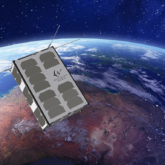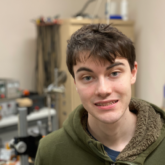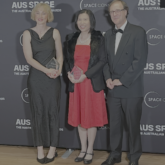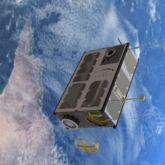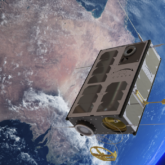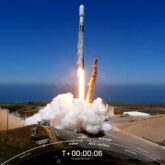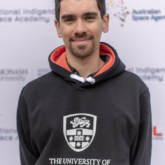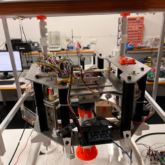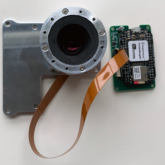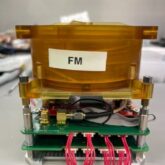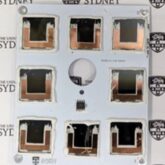14 / 08 / 2025
Our Australian built and operated sister-satellite, Waratah Seed, has won the SmallSat Mission of the Year award at the SmallSat Conference in Salt Lake City, Utah, USA. Backed by voting Australians and supported by the judges, Waratah Seed was crowned winner in of a field of 10 missions, including finalists from NASA Goddard, the European Space Agency, Purdue University, NASA’s Jet Propulsion Laboratory and Johns Hopkins University. The Mission of the Year award is a...
10 / 08 / 2025
Waratah Seed-1 a Finalist for Mission of the Year Sister-satellite to CUAVA-2, the Waratah Seed-1 satellite mission has secured a spot on the finals for the AIAA Small Satellite Mission of the Year Award. The prestigious Small Satellite Mission of the Year Award, presented by the American Institute of Aeronautics and Astronautics, includes finalists from NASA and the European Space Agency. Australians have the chance to support our ‘little Aussie satellite’ in a Public Vote...
09 / 07 / 2025
CUAVA PhD student Lachlan Goulden's research has been featured in two prominent science research publications. CUAVA congratulates Lachlan and his co-authors, whose research paper ‘Measurements of the force produced by a negatively charged electric sail in a pulsed cathodic arc plasma’ has been featured in two prominent science publications, Scilight and Physics of Plasmas. Electric sails are designed to harness the movement of flowing plasma such as solar wind for spacecraft acceleration and propulsion, and...
30 / 05 / 2025
CUAVA congratulates Australian Space Awards 2025 winners, Anita Ho-Baillie and Anne Bettens. Anita Ho-Baillie, who won the Academic of the Year Award 2025, is the John Hooke Chair of Nanoscience at Sydney Nano in the University of Sydney, and leads EurokaPower, whose perovskite solar cells have been successfully demonstrated on the Waratah Seed-1 mission and are also flying on CUAVA-2. Dr Anne Bettens won the Rising Star of the Year Award - SME for startup...
20 / 03 / 2025
CUAVA-2 Satellite – Results and Radiation CUAVA, the Australian Research Training Centre for CubeSats, UAVs and their Applications led by the University of Sydney, announces the CUAVA-2 satellite has now exceeded its anticipated lifespan, remaining in orbit for over 200 days. Download Media Release CUAVA-2 is the third satellite built by CUAVA in the School of Physics at the University of Sydney. The satellite was launched alongside the Waratah Seed-1 and built by the same...
16 / 12 / 2024
CUAVA, the Australian Research Training Centre for CubeSats, UAVs and their Applications led by the University of Sydney, is pleased to announce the CUAVA-2 satellite has now been in orbit for over 110 days, completing over 1800 revolutions around the Earth. Like its sister-satellite, Waratah Seed-1, the CUAVA-2 mission launched into orbit on 17 August 2024 (AEST) on the SpaceX Transporter 11 mission from Vandenberg Space Force Base. It was then successfully deployed approximately 515...
17 / 08 / 2024
We are thrilled to share that this morning Sydney time both the CUAVA-2 and Waratah Seed-1 CubeSats were deployed into orbit by Exolaunch and SpaceX (first image) and that both satellites are alive, well, and communicating with us (second image). Congratulations and thank you to the many team members and partners that have made this possible, including all those at the ARC Training Centre for CubeSats, UAVs, and their Applications (CUAVA) , Waratah Seed Space...
23 / 08 / 2023
Congratulations to CUAVA student Lincoln Bourke, who is off to NASA! Limilngan and Mudburra man, Lincoln Bourke, an engineering and physics student, will spend 10 weeks at NASA's Jet Propulsion Laboratory exploring how equipment could interact with the surface of other planets. First joining CUAVA in 2022, Lincoln Bourke has been chosen as part of the first cohort for the National Indigenous Space Academy (NISA). NISA is based at Monash University and supported by the Australian...
18 / 07 / 2023
CUAVA is excited to announce the delivery of the Electro Permanent Magnetorquer (EPM) payload, in preparation for integration into the CUAVA-2 Satellite, scheduled for launch in early 2024. The Electro Permanent Magnetorquer is a CubeSat-ready magnetorquer designed by a team at the School of Aerospace, Mechanical and Mechatronic Engineering (AMME) at the University of Sydney. The team comprises of Zihao Wang, Xiaofeng Wu and Youngho Eun. Unlike conventional magnetometers, the electro-permanent magnetorquer utilises hard magnetic...
12 / 07 / 2023
CUAVA has reached a major milestone in our mission to launch CUAVA-2 in early 2024. We are thrilled to announce that we have received the flight model of the CROSS Star Tracker payload. The CROSS payload for CUAVA-2 is designed to demonstrate a wide-field-of-view (WFOV) star tracker. It is designed as a compact and cost-effective star tracker that removes barriers for CubeSats to achieve high accuracy attitude determination using known positions of bright stars as...
12 / 07 / 2023
CUAVA has reached a major milestone in our mission to launch CUAVA-2 in early 2024. We are excited to announce the delivery of the GPS Reflectometry Payload, Harry3. The CUAVA-2 GPS reflectometry payload is developed by a team from the Australian Centre for Space Engineering Research (ACSER) at the University of NSW. Key researchers on this team are Aldi Rivaldi, Joon Wayn Cheong, Eamonn Glennon, Phu Le, Ben Southwell and Andrew Dempster. The CUAVA-2 GPS...
06 / 07 / 2023
The Perovskites in Orbit Readiness Test (PORT) Payload has been delivered to CUAVA in preparation for its integration onto the CUAVA-2 Satellite. This delivery marks an exciting major milestone in our CUAVA-2 mission, set to launch in early 2024. Designed by the University of Sydney Space Solar Cell Research Team, led by Anita Ho-Baillie, Laura Granados, Tiaan Stals, Arafat Mahmud, David McKenzie, and Iver Cairns, the PORT payload seeks to be the first demonstration of...



